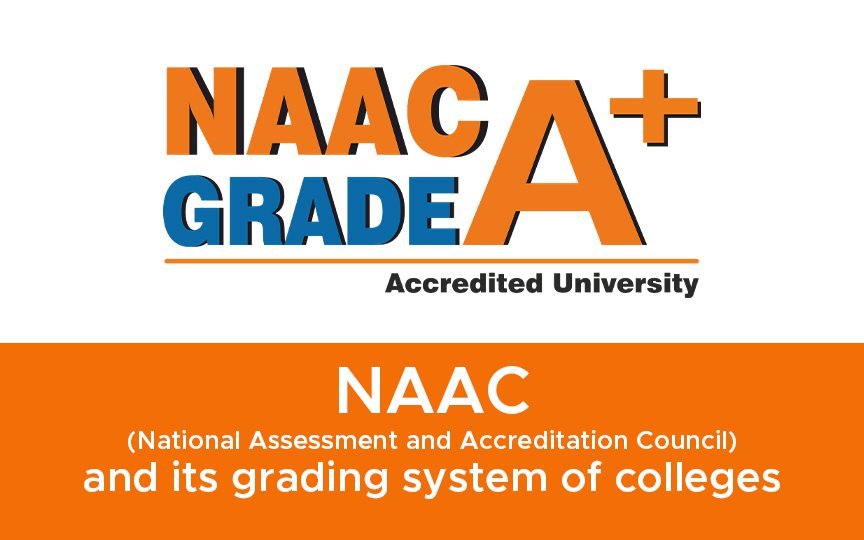About NAAC, it’s importance, benefits and the Grading system for Higher Education institutions
The National Assessment and Accreditation Council (NAAC) is an autonomous organization in India that assesses and accredits higher education institutions. NAAC was established by the University Grants Commission (UGC) in 1994 with the goal of improving the quality and excellence of higher education institutions in India. The NAAC accreditation system plays a crucial role in evaluating and ensuring the quality of education and infrastructure in Indian colleges and universities.
NAAC accreditation is a voluntary process, but it is highly respected and valued by Higher Education Institutions, students, and employers.
NAAC accreditation is important because it helps to ensure that HEIs are providing a quality education to their students. It also helps to promote transparency and accountability in higher education. In addition, NAAC accreditation can help HEIs to attract and retain faculty, staff, and funding.
Benefits of NAAC Accreditation
There are many benefits to NAAC accreditation for HEIs. Some of the key benefits included:
Improved quality of education: NAAC accreditation helps HEIs improve the quality of their education by providing them with a framework for self-evaluation and improvement.
- Increased student enrollment: NAAC-accredited HEIs are often more attractive to students than non-accredited HEIs. This is because students can be confident that they will receive a quality education at an NAAC
- C accredited institution.
- Enhanced reputation: NAAC accreditation helps to enhance the reputation of HEIs. This can make it easier for HEIs to attract faculty, staff, and funding.
- Improved access to funding: NAAC-accredited HEIs are often eligible for more funding opportunities than non-accredited HEIs.
- Greater international recognition: NAAC accreditation is recognized by many international organizations, which can make it easier for HEIs to attract international students and faculty.
How to Get NAAC Accredited
To get NAAC accredited, HEIs must undergo a rigorous self-study process and an on-site visit by a team of NAAC experts. The NAAC team will assess the HEI’s performance in a number of areas, including:
- Curriculum and pedagogy
- Faculty qualifications
- Research and development
- Infrastructure and facilities
- Student support services
If the HEI (Higher is found to meet NAAC’s standards, it will be granted accreditation. Accreditation is valid for a period of five years
NAAC Grades
Institutions that meet the highest standards receive an “A++” grade. “A+” is the next highest grade, followed by “A,” “B++,” “B,” “C,” and “D.” The “D” grade indicates that an institution does not meet the minimum criteria for accreditation.
- Validity and Reaccreditation: NAAC accreditation is typically valid for a specific period, after which institutions must undergo the accreditation process. Reaccreditation helps ensure that institutions continue to maintain and improve their quality over time.
- Continuous Quality Improvement: NAAC emphasizes the concept of Continuous Quality Improvement (CQI). Accredited institutions are encouraged to implement CQI processes to ensure ongoing enhancements in teaching, research, infrastructure, and other areas.
- Mandatory for Some Purposes: In India, NAAC accreditation is often a mandatory requirement for various purposes, such as eligibility for certain government funding schemes, participation in certain academic and research programs, and eligibility for autonomous status.
- Global Comparisons: NAAC accreditation allows Indian institutions to be compared with international counterparts in terms of quality and standards, facilitating collaborations and partnerships with foreign universities.
- Transparency: NAAC’s accreditation process is designed to be transparent and fair. Institutions are provided with clear guidelines, and the assessment is carried out by a team of experts with diverse backgrounds.
In addition to the benefits listed above, NAAC accreditation can also:
- Help HEIs to identify and address their strengths and weaknesses
- Provide HEIs with a roadmap for improvement
- Help HEIs to benchmark their performance against other HEIs
- Make HEIs more accountable to their stakeholders
How does the NAAC accreditation system provide grading to colleges?
The NAAC accreditation system provides gradation to colleges based on their performance and compliance with specific criteria and parameters. This gradation is represented by a letter grade on a seven-point scale, ranging from A++ to D, with A++ being the highest grade and D being the lowest. Here’s how the NAAC accreditation system assigns grades to colleges:
- Assessment Criteria: NAAC uses a set of criteria and parameters to assess colleges. These criteria cover various aspects of the institution, including infrastructure, teaching and learning processes, research and innovation, governance and leadership, student support services, and more. These criteria are further divided into sub-criteria.
- Quantitative and Qualitative Metrics: NAAC uses both quantitative and qualitative metrics to evaluate colleges. Quantitative data includes factual information and statistics provided by the institution. Qualitative data involves the assessment team’s observations, interviews, and feedback.
- Self-Study Report (SSR): Colleges seeking accreditation are required to prepare a Self-Study Report (SSR). This report provides a comprehensive overview of the institution’s activities and initiatives related to the NAAC criteria. It serves as the basis for the assessment.
- Peer Review: NAAC conducts a peer review process where a team of experts, including faculty members and administrators from other accredited institutions, visit the college to assess its compliance with the criteria. This team conducts an on-site visit, examines documents, interacts with stakeholders, and evaluates the institution’s facilities and processes.
- Scoring and Weightage: Each criterion and sub-criterion is assigned a specific weightage. During the assessment, the team assigns scores to the institution’s performance for each criterion based on the evidence provided and observations made during the visit.
- Calculation of Cumulative Grade Point Average (CGPA): After scoring each criterion, NAAC calculates a Cumulative Grade Point Average (CGPA) for the institution. The CGPA is a weighted average of the scores assigned to different criteria and sub-criteria.
Mathematical calculation of grades
The specific mathematical formula for calculating the CGPA is as follows:
CGPA = (Σ [Wi x Si]) / ΣWi
Where:
CGPA is the Cumulative Grade Point Average.
Σ represents summation (the sum of values).
- Wi represents the weightage assigned to each criterion or sub-criterion.
- Si represents the score assigned to each criterion or sub-criterion.
Here’s how the formula works in more detail:
- Calculate the product of the weightage (Wi) and the score (Si) for each criterion and sub-criterion. This gives you a set of individual products.
- Sum up all these individual products for all criteria and subcriteria.
- Sum up the weightages (Wi) for all criteria and sub-criteria separately.
- Divide the sum of the products by the sum of the weightages.
The resulting CGPA is a numerical representation of the institution’s overall performance based on the weighted scores assigned to each criterion and sub-criterion.
Once the CGPA is calculated, it is used to determine the final letter grade for the institution according to the NAAC’s seven-point scale, ranging from A++ to D. Please note that the specific weightages for criteria and sub-criteria may vary from one accreditation cycle to another, and they are determined by the NAAC.
Institutions seeking accreditation will receive guidance on the weightages and scoring system for their particular assessment.
Grade Assignment: Based on the calculated CGPA, the institution is assigned a letter grade according to the seven-point scale. The grade represents the overall quality and performance of the institution. The scale is as follows:
A++ (Highest)
A+
A
B++
B
C
D (Lowest)
Report and Feedback: The institution receives a detailed assessment report, including feedback and recommendations for improvement. This report helps the institution understand its strengths and weaknesses.
Publication of Results: NAAC publishes the accreditation status and grade of the institution on its official website, making it accessible to the public and stakeholders.
Reaccreditation: Accreditation is typically valid for a specific period, after which the institution must undergo the accreditation process to maintain or improve its grade.
The NAAC accreditation process is rigorous and aims to provide an objective assessment of the quality of education and infrastructure in colleges. The assigned grade reflects the institution’s adherence to quality standards and its commitment to continuous improvement. It helps students, parents, and other stakeholders make informed decisions about the quality of education offered by a particular college.
List of some of the Indian colleges having NAAC A+ grade accreditation
- Indian Institute of Technology, Madras (IIT Madras) – Chennai, Tamil Nadu
- Indian Institute of Technology, Bombay (IIT Bombay) – Mumbai, Maharashtra
- Indian Institute of Technology, Kharagpur (IIT Kharagpur) – Kharagpur, West Bengal
- Indian Institute of Technology, Delhi (IIT Delhi) – New Delhi
- Indian Institute of Technology, Kanpur (IIT Kanpur) – Kanpur, Uttar Pradesh
- Indian Institute of Technology, Roorkee (IIT Roorkee) – Roorkee, Uttarakhand
- Indian Institute of Technology, Guwahati (IIT Guwahati) – Guwahati, Assam
- Indian Institute of Technology, Hyderabad (IIT Hyderabad) – Hyderabad, Telangana
- Indian Institute of Technology, Gandhinagar (IIT Gandhinagar) – Gandhinagar, Gujarat
- Indian Institute of Technology, Ropar (IIT Ropar) – Rupnagar, Punjab
- Indian Institute of Technology, Bhubaneswar (IIT Bhubaneswar) – Bhubaneswar, Odisha
- Indian Institute of Technology, Patna (IIT Patna) – Patna, Bihar
- Indian Institute of Technology, Indore (IIT Indore) – Indore, Madhya Pradesh
- Indian Institute of Technology, Mandi (IIT Mandi) – Mandi, Himachal Pradesh
- Indian Institute of Technology, Palakkad (IIT Palakkad) – Palakkad, Kerala
- Indian Institute of Technology, Tirupati (IIT Tirupati) – Tirupati, Andhra Pradesh
- Indian Institute of Technology, Bhilai (IIT Bhilai) – Bhilai, Chhattisgarh
- Indian Institute of Technology, Goa (IIT Goa) – Ponda, Goa
- Indian Institute of Technology, Jammu (IIT Jammu) – Jammu, Jammu and Kashmir
- Indian Institute of Technology, Dharwad (IIT Dharwad) – Dharwad, Karnataka
- Indian Institute of Technology, Jodhpur (IIT Jodhpur) – Jodhpur, Rajasthan
- St. Stephen’s College – New Delhi
- Lady Shri Ram College for Women (LSR) – New Delhi
- Hindu College – New Delhi
- Presidency College – Kolkata, West Bengal
- St. Xavier’s College – Mumbai, Maharashtra
- Loyola College – Chennai, Tamil Nadu
- Miranda House – New Delhi
- Christ University – Bengaluru, Karnataka
- Ramjas College – New Delhi
- Madras Christian College (MCC) – Chennai, Tamil Nadu
- St. Joseph’s College – Bengaluru, Karnataka
- Sri Venkateswara College – New Delhi
- Fergusson College – Pune, Maharashtra
- Mount Carmel College – Bengaluru, Karnataka
- Delhi College of Arts and Commerce (DCAC) – New Delhi
- National Institute of Fashion Technology (NIFT) – Multiple Locations
- Hansraj College – New Delhi
- Stella Maris College – Chennai, Tamil Nadu
- Kirori Mal College – New Delhi
- Gargi College – New Delhi
- Narsee Monjee College of Commerce and Economics – Mumbai, Maharashtra
- National Law School of India University (NLSIU) – Bengaluru, Karnataka
- Indian Statistical Institute (ISI) – Kolkata, West Bengal
- Symbiosis College of Arts and Commerce – Pune, Maharashtra
- Hinduja College of Commerce – Mumbai, Maharashtra
- Lady Brabourne College – Kolkata, West Bengal
- Mount Carmel College for Women – Bengaluru, Karnataka
- Shri Ram College of Commerce (SRCC) – New Delhi
- Sophia College for Women – Mumbai, Maharashtra
- Kamala Nehru College – New Delhi
- St. Xavier’s College – Kolkata, West Bengal
- National Institute of Technology (NIT) Trichy – Tiruchirapalli, Tamil Nadu
- Indian Institute of Technology (IIT) Ropar – Rupnagar, Punjab
- Jamia Millia Islamia – New Delhi
- Indian Institute of Technology (IIT) Gandhinagar – Gandhinagar, Gujarat
- Banaras Hindu University (BHU) – Varanasi, Uttar Pradesh
- St. Xavier’s College – Mumbai, Maharashtra
- Indian Institute of Technology (IIT) Jammu – Jammu, Jammu and Kashmir
- Sri Ramakrishna College of Arts and Science – Coimbatore, Tamil Nadu
- St. Xavier’s College – Ahmedabad, Gujarat
- Aligarh Muslim University (AMU) – Aligarh, Uttar Pradesh
- Indian Institute of Technology (IIT) Mandi – Mandi, Himachal Pradesh
- Loyola College – Kochi, Kerala
- National Institute of Technology (NIT) Calicut – Kozhikode, Kerala
- Christ College – Irinjalakuda, Kerala
- Indian Institute of Technology (IIT) Bhilai – Bhilai, Chhattisgarh
- Xavier Institute of Social Service (XISS) – Ranchi, Jharkhand
- National Institute of Technology (NIT) Surathkal – Surathkal, Karnataka
- Tata Institute of Social Sciences (TISS) – Mumbai, Maharashtra
- St. Joseph’s College – Trichy, Tamil Nadu
- Indian Institute of Technology (IIT) Bhubaneswar – Bhubaneswar, Odisha
- Indian Institute of Technology (IIT) Goa – Ponda, Goa
- St. Xavier’s College – Jaipur, Rajasthan
- Indian Institute of Technology (IIT) Dharwad – Dharwad, Karnataka
- Narsee Monjee Institute of Management Studies (NMIMS) – Mumbai, Maharashtra
- National Institute of Technology (NIT) Warangal – Warangal, Telangana
- Jamia Hamdard University – New Delhi
- Indian Institute of Technology (IIT) Palakkad – Palakkad, Kerala
- Hansraj College – New Delhi
- Manipal Institute of Technology – Manipal, Karnataka
- Indian Institute of Technology (IIT) Tirupati – Tirupati, Andhra Pradesh
- Xavier Institute of Management and Entrepreneurship (XIME) – Bengaluru, Karnataka
- National Institute of Technology (NIT) Rourkela – Rourkela, Odisha
- Indian Institute of Technology (IIT) Hyderabad – Hyderabad, Telangana
- National Institute of Design (NID) – Ahmedabad, Gujarat
- Indian Institute of Technology (IIT) Kanpur – Kanpur, Uttar Pradesh
- National Institute of Fashion Technology (NIFT) – Delhi, Mumbai, and other locations
- Jamnalal Bajaj Institute of Management Studies (JBIMS) – Mumbai, Maharashtra
- Indian Statistical Institute (ISI) – Delhi, Kolkata, and other locations
- Indian Institute of Technology (IIT) Bombay – Mumbai, Maharashtra
- Indian Institute of Technology (IIT) Kanpur – Kanpur, Uttar Pradesh
- Delhi Technological University (DTU) – New Delhi
- National Institute of Technology (NIT) Jaipur – Jaipur, Rajasthan
- Indian Institute of Management (IIM) Calcutta – Kolkata, West Bengal
- Indian Institute of Technology (IIT) Roorkee – Roorkee, Uttarakhand
- Anna University – Chennai, Tamil Nadu
- Indian Institute of Management (IIM) Lucknow – Lucknow, Uttar Pradesh
- National Institute of Technology (NIT) Kurukshetra – Kurukshetra, Haryana
- Indian Institute of Technology (IIT) Patna – Patna, Bihar
- Xavier Labour Relations Institute (XLRI) – Jamshedpur, Jharkhand
- Indian Institute of Technology (IIT) Jodhpur – Jodhpur, Rajasthan
- Jawaharlal Nehru University (JNU) – New Delhi
- Indian Institute of Technology (IIT) Ropar – Rupnagar, Punjab
- National Institute of Technology (NIT) Hamirpur – Hamirpur, Himachal Pradesh
- Indian Institute of Management (IIM) Ahmedabad – Ahmedabad, Gujarat
- National Institute of Technology (NIT) Silchar – Silchar, Assam
- Indian Institute of Technology (IIT) Hyderabad – Hyderabad, Telangana
- Indian Institute of Management (IIM) Bangalore – Bengaluru, Karnataka
- National Institute of Technology (NIT) Durgapur – Durgapur, West Bengal
- Indian Institute of Technology (IIT) Indore – Indore, Madhya Pradesh
- National Institute of Technology (NIT) Agartala – Agartala, Tripura
- Indian Institute of Management (IIM) Kozhikode – Kozhikode, Kerala
- Indian Institute of Technology (IIT) Bhilai – Bhilai, Chhattisgarh
- National Institute of Technology (NIT) Meghalaya – Shillong, Meghalaya
- Indian Institute of Technology (IIT) Bhubaneswar – Bhubaneswar, Odisha
- Tata Institute of Fundamental Research (TIFR) – Mumbai, Maharashtra
- Indian Institute of Technology (IIT) Goa – Ponda, Goa
- Indian Institute of Management (IIM) Indore – Indore, Madhya Pradesh
- National Institute of Technology (NIT) Nagaland – Dimapur, Nagaland
- National Institute of Fashion Technology (NIFT) – Delhi, Mumbai, and other locations
- Indian Institute of Technology (IIT) Dharwad – Dharwad, Karnataka
- Indian Institute of Management (IIM) Udaipur – Udaipur, Rajasthan
- National Institute of Technology (NIT) Jamshedpur – Jamshedpur, Jharkhand
- Indian Institute of Technology (IIT) Palakkad – Palakkad, Kerala
- Indian Institute of Management (IIM) Shillong – Shillong, Meghalaya
- National Institute of Technology (NIT) Manipur – Imphal, Manipur
- Indian Institute of Technology (IIT) Tirupati – Tirupati, Andhra Pradesh
- Indian Institute of Management (IIM) Raipur – Raipur, Chhattisgarh
- Indian Institute of Technology (IIT) Gandhinagar – Gandhinagar, Gujarat
- Indian Institute of Management (IIM) Kashipur – Kashipur, Uttarakhand
Conclusion
Overall, NAAC accreditation serves as a mechanism to ensure and enhance the quality of higher education in India, fostering excellence in teaching, research, and institutional management. It plays a pivotal role in promoting a culture of continuous improvement and accountability in higher education institutions across the country.
NAAC accreditation is a valuable asset for HEIs. It can help them to improve the quality of their education, attract students and faculty, and enhance their reputation.







